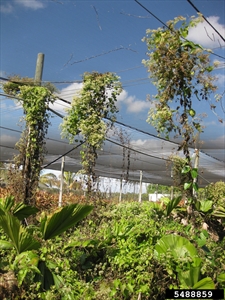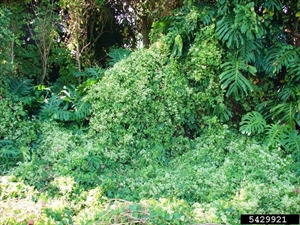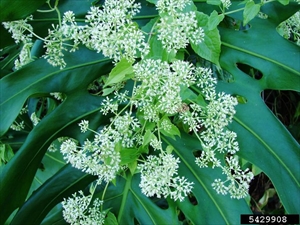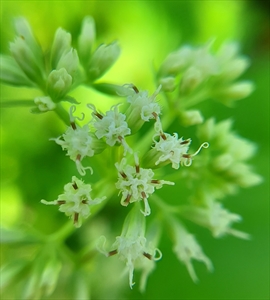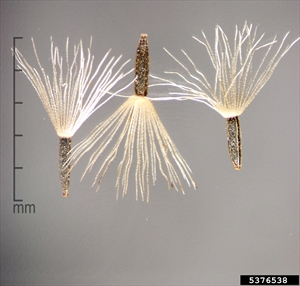Mile-a-minute; it is also known as mikania, mikania vine, or Chinese creeper. CABI prefers bitter vine.
Pacific Pests, Pathogens, Weeds & Pesticides - Online edition
Pacific Pests, Pathogens, Weeds & Pesticides
Mile-a-Minute (466)
Mikania micrantha. Another species Mikania cordata is similar. Both are members of the Asteraceae.
Asia, Africa (restricted to Reunion and Mauritius), North, South and Central America, the Caribbean, Oceania. It is recorded from Australia, American Samoa, Cook Islands, Federated States of Micronesia, Fiji, Guam, Kiribati, Marshall Islands, New Caledonia, Niue, Northern Mariana Islands, Palau, Papua New Guinea, Samoa, Solomon Islands, Tonga, Tuvalu, Vanuatu, and Wallis & Futuna.
It is native to Mexico and Central America, the Caribbean, and tropical South America.
A fast-growing, much-branched, long-lived, climbing vine with stems up to 6 m, smothering and killing plantation and other agricultural crops, as well as native species (Photos 1&2). Its invasive weediness is due to fast growth, the production of large numbers of seeds, and an ability to grow from stem cuttings, making it difficult to control. It thrives in open, sunny, disturbed situations, but will also tolerate partial shade.
It is absent from continental Africa, but invasive in Southeast Asia in oil palm, coconut, cocoa, tea (where it encourages the tea mosquito), teak and rubber plantations and, in Pacific island countries, a major weed in young coconut and forestry plantations, taro gardens, and clearings in disturbed primary forests. It can climb and smother trees up to 25 m.
The stems are slender, ribbed lengthwise, hairless or only slightly hairy (Photo 3). They produce roots from the swellings (nodes) along the stem where the leaves emerge. The leaves are smooth, heart-shaped, 4-13 cm in length, with stalks 2-8 cm long, arranged in opposite pairs along the stem (Photo 3). The margins of the leaves vary from shallow to coarsely-toothed. Flowerheads, borne in flat-topped clusters from stalks between leaves and stem or from the tips of the branches; they are white or greenish-white (Photo 4). The individual flowers are 3-5 mm long. The stamens (male parts) are long and protrude beyond the tube of the flowers (Photo 5). Seeds are black, 1.5–2 mm long, thin and flattened. Each seed has a parachute-like tuft of fine whitish bristles ('pappus') that are 2–3 mm long (Photo 6).
A single plant can produce up to 40,000 seeds a year. The tuft of hairs (pappus) assists dispersal by wind. Spread can also be by animals, machinery and flood water. Short-distance spread also occurs vegetatively when, for instance, slashing creates stem pieces that root at the nodes. The weed has been intentionally introduced as a ground-cover in plantations and for soil conservation.
There is a view, in some Pacific island countries, that mile-a-minute is preferable to the many alternative weeds that might occupy the space if mile-a-minute were controlled. It is relatively easy to slash, roll up and remove. However, in Vanuatu, it has been estimated that in new forestry plantings, mile-a-minute and Merremia (see Fact Sheet no. 446) together require 106 days of hand weeding per hectare over the first 3 years. Also, mile-a-minute produces toxins which, when released into the soil, reduce the growth of other agricultural crops and native vegetation (allelopathy). In addition, surveys in Papua New Guinea before the release of the rust fungus, Puccina spegazzinii, found that 40% of the respondents considered that the weed reduced crop yields by more than 30%. In Fiji, the figures were 65% of respondents and 30% of potential crop yield. In Southeast Asia, too, there are reports of the high cost of control in plantations of tea, cocoa, oil palm and rubber. Cost to the plantation industries in Malaysia were nearly $US10 million in 1985, so costs today would be several times higher.
Mile-a-minute is eaten by cattle, used to prevent soil erosion, and as a mulch, although it has a high water content and decomposing rapidly. In Fiji, it is used to stop minor bleeding from cuts, and also in parts of India. Many other medicinal uses are reported, but they have not been thoroughly investigated..
BIOSECURITY
The risk of introduction is high. Countries not yet infested should consider all likely pathways for entry, and apply quarantine measures accordingly. Particular attention should be given to the risks associated with seed that can be transported on machinery and on clothing.
Mile-a-minute is a 'restricted invasive plant' under biosecurity acts in some parts of Australia; this means - a person must not release these invasive plants into the environment, give away or sell as a plant or something infested with its seeds. Mikania micrantha is among the 100 of the World's Worst Invasive Alien Species compiled by the Global Invasive Species Database, maintained by the IUCN Invasive Species Specialist Group, 2020. Mile-a-minute is one of the most important weeds in Cook Islands, Fiji, Niue, America Samoa, Samoa, Solomon Islands and Vanuatu.
BIOCONTROL
The rust fungus, Puccinia spegazzinii, from Ecuador, was introduced into Papua New Guinea and Fiji in 2008 and is said to offer great potential for the control of the weed. It has also been released in Solomon Islands and Vanuatu. Other strains have been released in India beginning in 2005, but without success. Releases in China were also unsuccessful, but the rust established in Taiwan. Insects, too, have potential to bring about control; Liothrips mikaniae, from Central and South America, has been suggested by Waterhouse & Norris. The psyllid, Heteropsylla spinulosa has been released in Fiji, Papua New Guinea and Samoa. More recently, the butterflies, Actinote anteas and Actinota pyrrha have shown promise.
CULTURAL CONTROL
- Physical & Mechanical:
- Hand weeding. Can be effective if done frequently, and before plants shed seeds. Hoeing is also recommended, as is slashing, but vines are likely to recover rapidly from regrowth of broken stem pieces.
- Ploughing. In Fiji, ploughing before planting taro was superior to hand-weeding or slashing because the plants were buried instead of being left on the ground where they regrew.
- Use livestock. Both sheep and cattle will eat mikania, although liver damage is reported in cattle.
- Hygiene:
- Treat vehicles and farm machinery. If moving from areas where the weed occurs to those weed-free, wash to remove soil. This is equally important if the machinery is being imported into a country or moved within a country.
CHEMICAL CONTROL
In Australia: fluroxypyr; glyphosate (and Fiji); metsulfuron-methyl, are registered for use against mile-a-minute. Elsewhere, 2,4-D.
--------------------
Note, EU approval to use glyphosate ends in December 2022; its use after that date is under discussion.
____________________
When using a pesticide, always wear protective clothing and follow the instructions on the product label, such as dosage, timing of application, and pre-harvest interval. Recommendations will vary with the crop and system of cultivation. Expert advice on the most appropriate herbicides to use should always be sought from local agricultural authorities.
AUTHORS Grahame Jackson, Aradhana Deesh & Mani Mua
Adapted from Mikania vine (Mikania micrantha) (2018) Weeds of SE Qld and Northern NSW. Lucidcentral. (https://www.lucidcentral.org/editors-pick-animal-and-plant-identification-keys/key-to-weeds-of-se-qld-and-northern-nsw); and additional information from CABI (2019) Mikania micrantha (bitter vine). Invasive Species Compendium. (https://www.cabi.org/isc/datasheet/34095); and Mikania micrantha. Waterhouse DF, Norris KR (1987) Biological Control Pacific Prospects. Inkata Press, Melbourne; and Mikania vine (Mikania micrantha) (2018) NSW Weedwise. Department of Primary Industries. NSW Government. (https://weeds.dpi.nsw.gov.au/Weeds/MikaniaVine); and from Mikania vine Mikania micrantha (2016) Biosecurity Queensland, Department of Agriculture and Fisheries. Photo 1 Andrew Derksen, USDA-APHIS, Bugwood.org. Photo 2-4 Dennis J. Giardina, Florida Fish and Wildlife Conservation Commission , Bugwood.org. Photo 6 Julia Scher, Federal Noxious Weeds Disseminules, USDA APHIS PPQ, Bugwood.org.
Produced with support from the Australian Centre for International Agricultural Research under project HORT/2016/185: Responding to emerging pest and disease threats to horticulture in the Pacific islands, implemented by the University of Queensland, in association with the Pacific Community and Koronivia Research Station, Ministry of Agriculture, Fiji.
